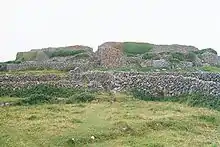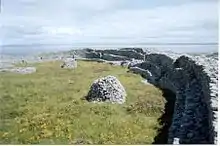Dún Conor
Dún Conor is a stone ringfort (cashel) and National Monument located on Inishmaan, Ireland.[3][4][5][6]
| Dún Conor | |
|---|---|
| Native name Irish: Dún Crocbhur · Dún Chonchuir · Dún Chonchubhair | |
| Conor's Fort, Doonconor, The Black Fort[1] | |
 | |
| Type | stone ringfort |
| Location | Carrowntemple, Inishmaan, County Galway, Ireland |
| Coordinates | 53°05′00″N 09°35′41″W |
| Area | 1,900 m2 (0.47 acres) |
| Elevation | 73 m (240 ft) |
| Height | 5 m (16 ft) |
| Architectural style(s) | Gaelic Ireland |
| Owner | State |
| Official name | Dun Conor Cashel[2] |
| Reference no. | 42 |
 Location of Dún Conor in Ireland | |
History
The fort is believed to date back to the first or second millennium BC.[9] At that time, sea levels were lower and the Aran Islands part of the mainland, and the other forts like Dún Aengus were not on the coast. They have been heavily damaged by time and the sea, but Dún Conor's central location has protected it.[10] The name means "Conor's Fort;"[11] legends link it to Conor, son of Hua Mór and brother of Aengus.[12] The size of the forts on the Aran Islands gave rise to the legends of the Fir Bolg.[13]
John O'Donovan visited Dún Conor in 1839. The clocháns in the interior were restored in the 1880s.
Description
A stone ringfort with an irregular elliptical shape, internalling measuring about 69 m (226 ft) N-S and 35 m (115 ft) E-W; although smaller than Dún Aengus, it has thicker walls, up to 6 m (20 ft) in places.[14] It is built in four terraces with internal stairs. The west wall is built atop a natural internal cliff; the other sides are guarded by a second wall, with a bastion in the northeast.[15]
References
- "Top 5 Must See Attractions On Inis Meain". Doolin2Aran Ferries. 13 July 2016.
- https://www.archaeology.ie/sites/default/files/media/pdf/monuments-in-state-care-galway.pdf
- Westropp, T. J. (28 September 1902). The Ancient Forts of Ireland. Рипол Классик. ISBN 9785878572927 – via Google Books.
- Norman, Edward R. (28 September 1969). "The Early Development of Irish Society: The Evidence of Aerial Photography". CUP Archive – via Google Books.
- Healy, abp John (28 September 1912). "Insula Sanctorum Et Doctorum: Or, Ireland's Ancient Schools and Scholars". Sealy, Bryers & Walker – via Google Books.
- Spellissy, Sean (1 January 1999). The history of Galway. Celtic Bookshop. ISBN 9780953468331 – via Google Books.
- "Dún Crocbhur (Conor's Fort)".
- "Aer Arann Islands – Attractions of Inis Meáin". aerarannislands.ie.
- "Dún Crocbhur | Conor's Fort | Dún Chonchúir | Stone Fort Aran Islands".
- http://aran-islands-tsunami-shelters.com/leathnachdunchonchubhair.html
- Hammerton, Sir John Alexander (28 September 1933). "Wonders of the Past: The Romance of Antiquity and Its Splendors". William H. Wise – via Google Books.
- Healy, Rev John (9 June 2016). Insula Sanctorum Et Doctorum Or Ireland's Ancient Schools And Scholars. Read Books Ltd. ISBN 9781473361331 – via Google Books.
- "Inishmaan Bike Tour · Aran Islands Bike Tours".
- Lee, Helen (23 July 2018). The Little Book of Galway. History Press. ISBN 9780750989503 – via Google Books.
- magazine, University (28 September 1853). "The Dublin university magazine" – via Google Books.









